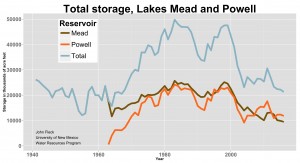
Data source: USBR. 2016 projection based on USBR October 2015 24-Month Study
Preparing to moderate a panel at next week’s Colorado River Water Users Association annual meeting, I’m struck by the mix of good news and bad news on the river. 2015 water use across some major user groups is at record lows for the modern era, something that I don’t think gets enough attention. But Lake Mead keeps dropping.
Being the optimist, I’ll start with the good news.
As we near the end of 2015, this morning’s Bureau of Reclamation year end water forecast (source pdf) includes some encouraging numbers:
- at 2.476 million acre feet, the Imperial Irrigation District’s forecast water use for the year is the lowest since at least 1964, which is the start of the bureau’s modern water accounting era
- Nevada is forecast to take a net (after return flows are accounted for) of just 222,441 acre feet from Lake Mead, the least water used in Las Vegas and surrounding areas since 1995. The region’s population has doubled since then.
- Arizona’s on-river agricultural communities (La Paz and Yuma counties, representing collectively the state’s biggest and oldest Colorado River ag water rights) are on track to use 936,000 acre feet of water, also the lowest since the modern accounting system was put in place.
- The Central Arizona Project, which moves water up out of the river corridor to Phoenix and Tucson and surrounding environs, is on track to pull 1.513 million acre feet from the river, which is the second lowest (after 2005) since the system was built out and began full operations in the late 1990s.
This clearly shows some significant “use less water” adaptive capacity in the system. And yet….
The bad news
Total reservoir storage on the Colorado River system as of Monday was just 50 percent (source pdf). Lake Mead ended November with a surface elevation of 1,078.23 feet above sea level, the lowest for that date since it was filling in 1938.
The balancing act
This is the balancing act – a need for a recognition of the seriousness of the problem (Lake Mead keeps dropping!) while simultaneously also recognizing that significant progress has been made in using less water, and learning the lessons offered by that progress.
Let me know if you’re going to CRWUA, track me down, say “hi”.

I, for one am optimistic. The glass is half full. I am also pragmatic. We shouldn’t gulp too deeply from the glass.
dg
Has not Lake Mead held between 1075 and 1080 ft for some time (since it was down to slightly below the 1075 ft mark)?
looking at the report it shows that the percentage from last year and this year is about the same which is largely due to conservation measures and also that miracle May they had.
seeing that northern CA finally got some decent rains this past week (and especially the past day or so) has been great! give those trees and animals a welcome drink!